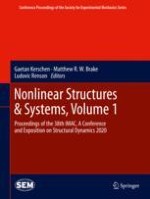2021 | OriginalPaper | Buchkapitel
6. Some Aspects of Using the Random Decrement Technique for Nonlinear Systems
verfasst von : Karsten K. Vesterholm, Rune Brincker, Anders Brandt
Erschienen in: Nonlinear Structures & Systems, Volume 1
Aktivieren Sie unsere intelligente Suche, um passende Fachinhalte oder Patente zu finden.
Wählen Sie Textabschnitte aus um mit Künstlicher Intelligenz passenden Patente zu finden. powered by
Markieren Sie Textabschnitte, um KI-gestützt weitere passende Inhalte zu finden. powered by
